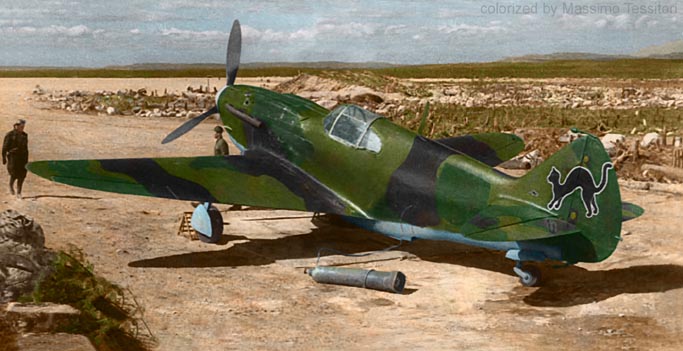
|
evolution of its painting scheme By Audrius Nairanauskas and Massimo Tessitori |
Updated on April 9, 2020

The most famous pilot of the 145 IAP, then based at Murmansk on the
Northern front, was Captain Leonid Galchenko, commander of the second squadron.
At the age of 29, Galchenko flew in 1939-40 war against Finland, without
being involved in aerial combats.
This unit was equipped with I-16s at the age of the Operation Barbarossa;
he obtained a single victory on this type.
The unit received a dozen of LaGG-3s in early August 1941. His first
flight ended with a landing gear collapse while landing.
Some days later, Galchenko shot down a Ju-88 with the midnight
sun in the sky. Then he started to be favourably impressed by his new aircraft.
He totalized 8 aerial victories within the end of September 1941.
|
|
The LaGG-3 of Leonid Galchenko was probably an example of series 2 or 3, built
in Gorki (Zavod 21) immediately before the war outbreak.
It featured intermediate characteristics between those of the better-known 1st
series and 4th series:
|
|
|
The Lagg-3 were supplied to 145 IAP on 22 July 1941. |
|
|
Galchenko was promoted major in late September 1941,
At that time, Galchenko was proposed as Hero of the Soviet Union, the highest
Soviet decoration, but he said that he would accept it only if his wingman Viktor
Mironov was awarded in the same way, because he had saved him many times from
sure death.
They both were made HSU on 6 June 1942.
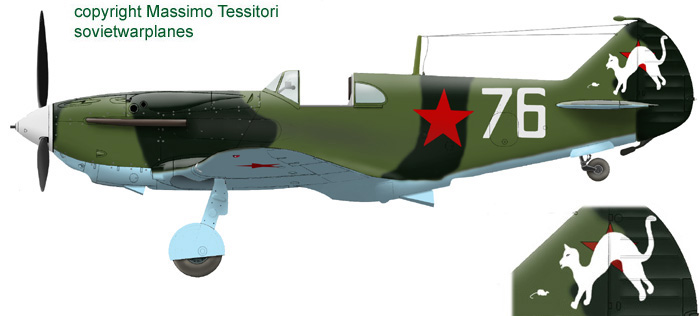 |
The famous white cat was painted in Semptember 1941; it is not clear
when the spinner was painted white. This profile was extrapolated from later photos shown below, removing the white winter camo. The most likely colors are AMT-4 and 6 for the uppersurfaces, and AII light blue for the undersurfaces. |
|
|
In period October-December/41 the 145 IAP was moved from the front and reorganized
into 609 IAP at Kandalaksha; this unit was equipped with I-16, LaGG-3 and MiG-3s.
Major Galchenko was made commander of the new unit.
The period of December-February/42 was of very active combats.
 |
Here are screenshots of a movie representing Galchenko's plane in winter 1941/42 (courtesy of Michal Sekula). These images led us to reconsider the previous version of the color drawings. The 'blotched' look of the white areas on the tail and wings is visible. |
|
|
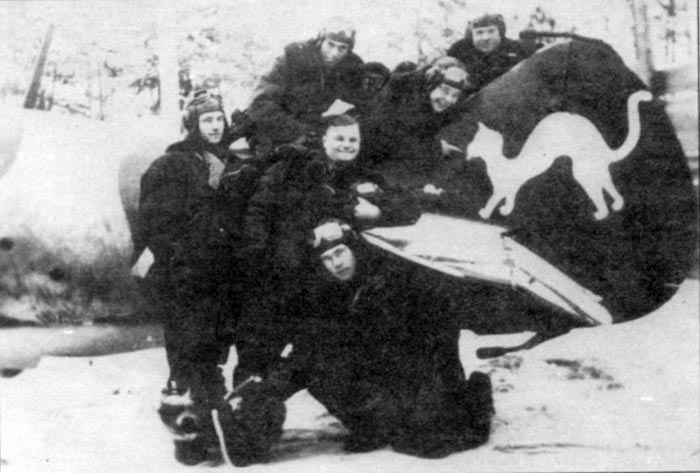 |
On the left side of the tail, a small mouse is in front of the cat; the mouse was missing on the other side. Note the blotchy look of the white areas on the stabilizers and elevators. The red star on the tail is very scarcely visible; probably it was partially obliterated with camo colors. |
|
Further images of Galchenko's plane in winter 1941/42. As on previous photos, the canopy is missing. The spinner appears fully painted white, without the red star that appeared in a later date. The small red stars under the wings are still visible. Some white areas can be perceived on the outer part of the wing leading edges. |
|
These images show what seems a repair on the left glazing, perhaps made with adhesive tape. On photos above, we see the light tape extending on the right side along the rear end of the cockpit opening. |
|
On these images, we can see the white cat on the right side; there was not any mouse painted in front of it on this side. The underlying red star is practically unvisible; it is likely that it was obliterated with camo colors. We see also some repaintings on the hinges of the rudder. |
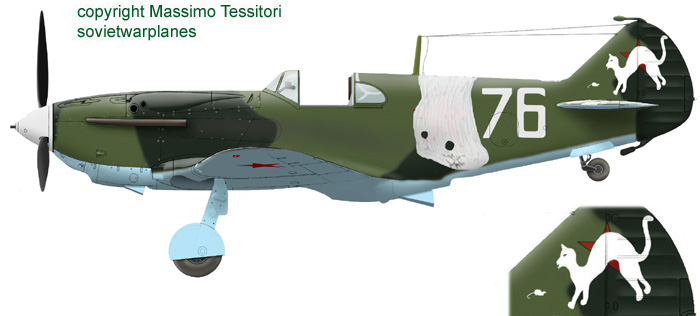 |
On the base of the photos above, these color drawings show:
|
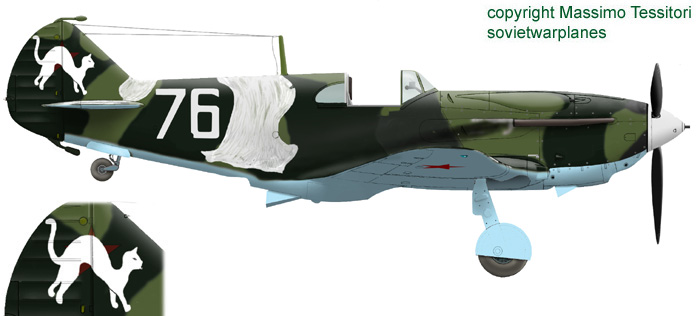 |
The white cat on the right side had different nose shape, and no mice.
A very visible paint scratch on the heat-resistant steel plate appears immediately behind the right exhaust stack. |
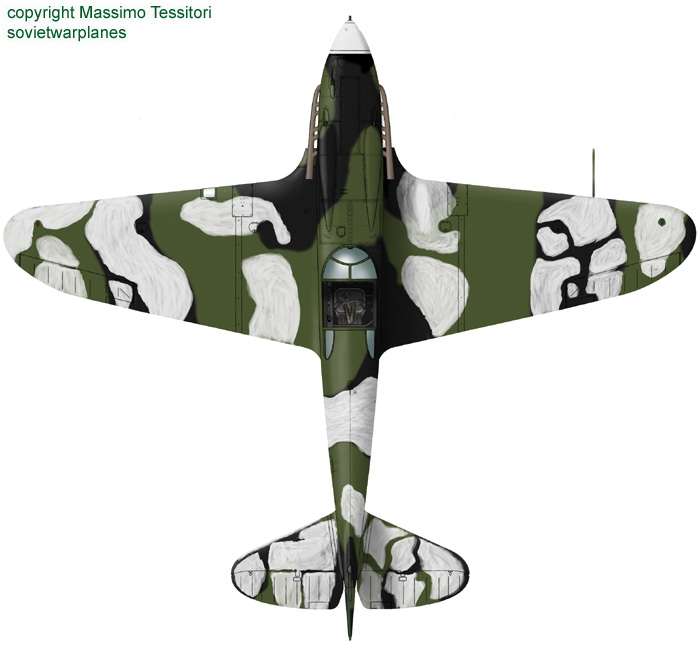 |
The upper view was reconstructed on the base of photos. While the white blotches on the tail are perfectly known, those on the wings are reconstructed from fragmentary photos and from the repaintings visible over the wings on later photos, probably due to the necessity to restore black-green areas ruined by the winter paint. |
|
|
During the spring 1942, the painting of the plane was changed in many ways.
The white blotches were removed, but the underlying paint was ruined, so it was retouched with new, glossy black and dark green paint that gave to the plane a very patchy look. The national insignas and the bort number on the fuselage were overpainted too; the red stars under the cat remained only barely visible. It looks that the underwing stars were deleted too.
All this deletion of national marking was compensated by the addition of a red star on the white spinner. The black cat and the mice received a new white outline.
A sliding hood was added, with unpainted canopy frames.
|
This image shows the aircraft as it appeared in spring/summer 1942. Image composed by Massimo Tessitori on the base of some screenshots from a wartime movie |
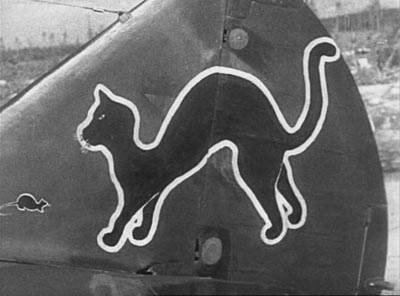 |
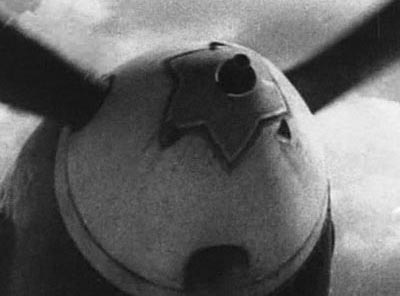 |
| Here we see a detail of the cat on the left side.
The mice is only on the left side, and the cat shape is a bit different on the other side. The nearly deleted red star is still visible under repaintings. On the rudder, we see light (red? Lighter green?) panels on black repaintings. |
Here is a detail of the star on the spinner. We see a very thin white-black-red contour. The angular distance between star braces looks irregular, but this could be an illusion due to the perspective and to the lock recess in upper position. |
|
Here is the aircraft flying during summer/spring 1942. |
|
This image shows not red stars under the wings, but this could be due to
some efect of the images. The red stars appear again in photos that are
believed to be later than this image, apparently with the same small size
and position.
|
|
Here is Galchenko near his aircraft's tail in 1942. The cat was already painted black with white outline. Photo from Artem V. Drabkin |
 |
A better detail of the cat, |
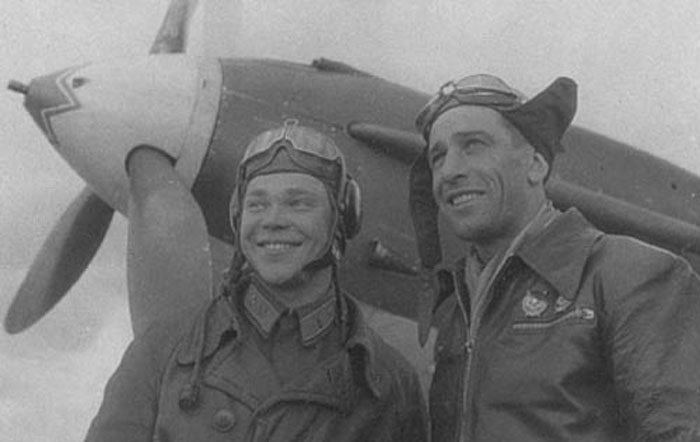 |
Another image of Galchenko and his fellow Mironov in 1942. Here we see the 12,7 mm gun protruding from his spinner and from the left side of the engine cowling and the side intake. Photo from Artem V. Drabkin |
|
A reconstruction of the look of Galchenko's plane in spring/summer 1942 based on the photos above. The base colors were probably AMT-4 and 6, but the difference between new and old paint is so apparent that the resulting camouflage was very patchy. |
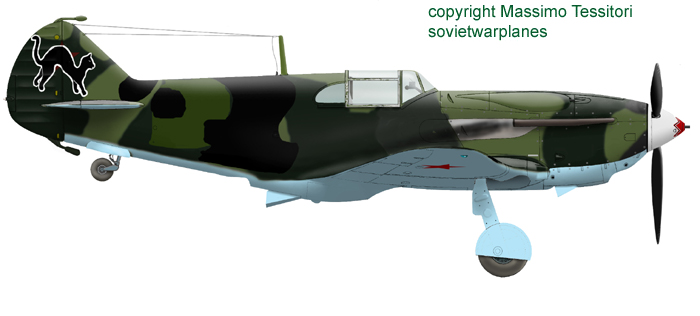 |
|
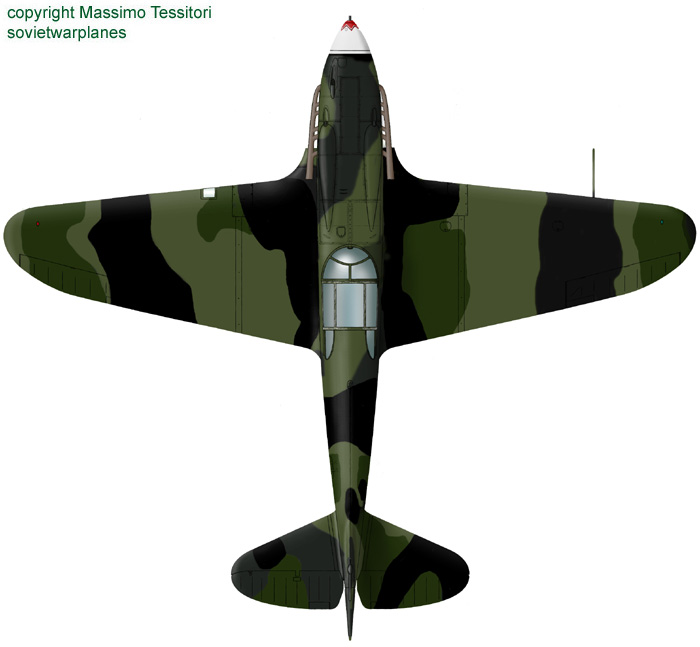 |
This upper view of Galchenko's aircraft is well documented on photos (except
for small details), and is the base for the reconstruction of earlier looks
of the aircraft. The sharp black and dark green bands correspond to winter white blotches repainted. |
|
|
According to bibliography, the Lagg with black cat was shot down once: it was not flown by Galchenko that was ill , but by his wingman Mironov. According to the report Mironov had to bail with the parachute, so it is likely that the plane was completely destroyed. According to the same report, Galchenko orederd to paint a black cat on each plane of the unit... but there isn't any evidence that this was really done. From the quoted source, it seems that this happened in mid 1942.
The image below is thought to show Galchenko's aircraft in a later date, probably the fall of 1942. On the whole, it's not sure that this is the same aircrafts of the photos above, maybe repaired with pieces from another one, or a new aircraft at all, maybe modified to match the previous one as colors and armament.
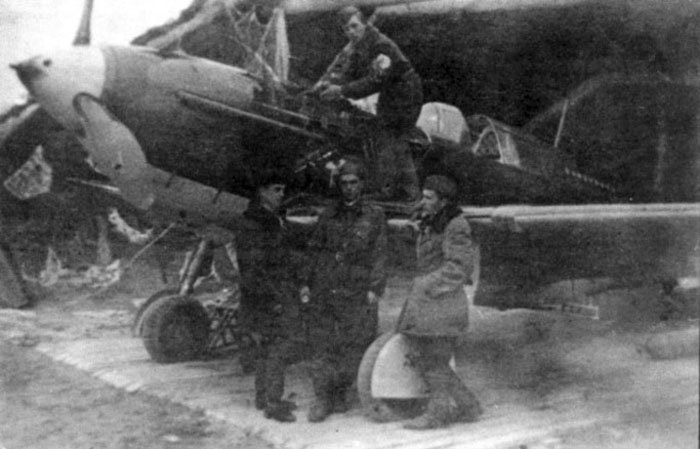 |
Note that some details are different:
As similarities with the first aircraft, we note:
|
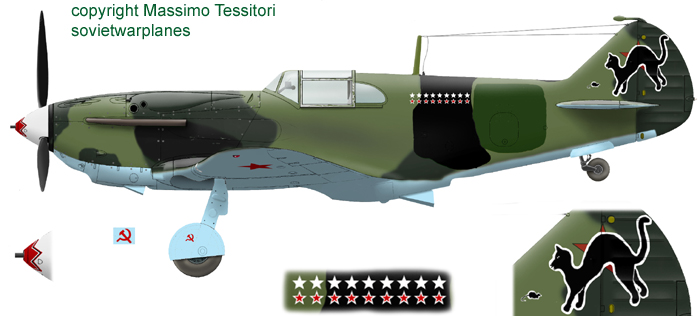 |
This drawing gives a reconstruction of the look of the plane on the photo above. |
|
|
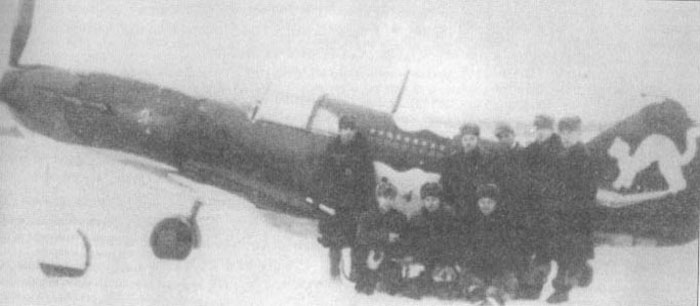 from Soviet aces on LaGG/Lavockins, Osprey; thanks to Alexander Ruchkovsky |
This image seem to show the same aircraft of the one above on a later
date, probably winter 1942/43. The cat was completely repainted white, including the previous white outline; so, it appears wider than on photos of a year before. The hammer and sickle on the wheel door is no longer visible.
|
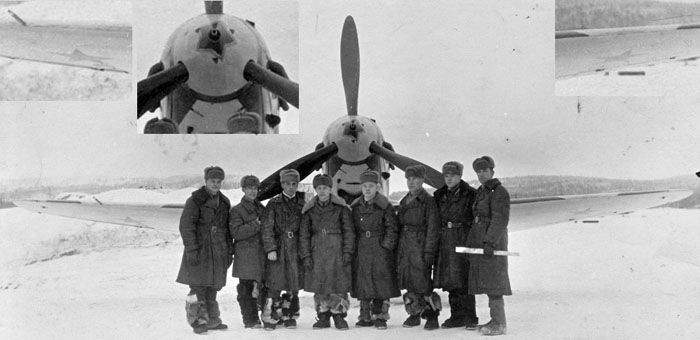 |
Clear image of the Lagg-3 of Galchenko, probably shat contemporarily to the one above. In fact we see the exhaust pipes of later type, the dark rear plate of the spinner, the same background and dresses. Note the presence of the red stars under the wings, apparently with the same small size and position visible in much earlier photos; so it is likely that the lack of underwing stars in some other photos is an illusion. |
 |
This photo shows Galchenko and the front of the plane, already provided with the red star on its spinner and the sliding hood; so it is likely that it was more or less contemporary to the photo above. Unfortunaltely the exhaust stacks are partially hidden by the head of the pilot, so it's hard to understand if they are the early one-tube configuration or the later three-tubes one. A detail that doesn't fit is the rear plate of the spinner, that appears whitish, more or less as on the photos of the winter before, while the photos above of late 1942 seem to show that the rear plate was black. Of course, this photo could be later than the previous ones and the piece could have been repainted white. |
|
A reconstruction of the look of Galchenko's plane in winter 1942/43 based on the photos above. It is likely that the victory starlets were painted on the left side
only; they appear on two photos, all from this side. |
Galchenko became deputy commander of 324 IAD (Fighter Aviation Division); he
received a La-5F, on whose tail he painted the cat emblem again.
He continued to fly and combat over the Arctic and on Karelia till the end of
the war, totalizing 24 individual victories, plus 12 shared, in 310 sorties.
Links:
http://massimotessitori.altervista.org/sovietwarplanes/board/index.php?topic=1445.0
http://airaces.narod.ru/all2/galchenk.htm
https://www.youtube.com/watch?v=a9-l2w9Lb90